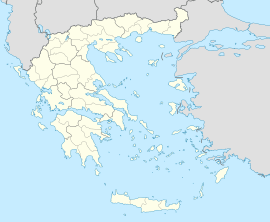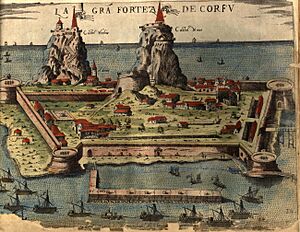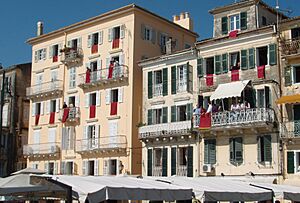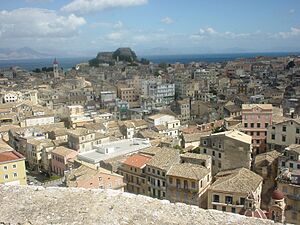Corfu (city) facts for kids
Quick facts for kids
Corfu
Κέρκυρα
(Χώρα) |
||
|---|---|---|
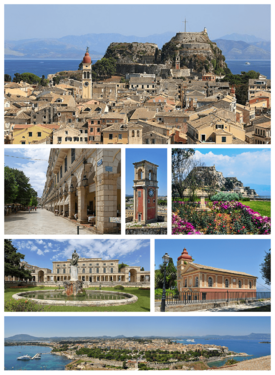 Clockwise from top: The Old Venetian Fortress and the Old Town of Corfu, as seen from the New Fortress, Venetian bell tower of Corfu, The Natura 2000-protected seaside from Kanoni to Mesoggi, Church of the Virgin Mary Mandrakina, Panoramic view of the city of Corfu, Palace of St. Michael and St. George, A characteristic street of Corfu.
|
||
|
||
| Country | Greece | |
| Administrative region | Ionian Islands | |
| Regional unit | Corfu | |
| Municipality | Central Corfu and Diapontia Islands | |
| • Municipal unit | 41.905 km2 (16.180 sq mi) | |
| Population
(2021)
|
||
| • Municipal unit | 40,047 | |
| • Municipal unit density | 955.662/km2 (2,475.15/sq mi) | |
| Demonym(s) | Corfiot (Greek: Κερκυραίος, -α "Kerkyreos") |
|
| Community | ||
| • Population | 30,737 (2021) | |
| Time zone | UTC+2 (EET) | |
| • Summer (DST) | UTC+3 (EEST) | |
| Postal code |
49100
|
|
| Area code(s) | 26610 | |
| Vehicle registration | ΚΥ | |
| Website | www.corfu.gr | |
| UNESCO World Heritage Site | ||
| Official name | Old Town of Corfu | |
| Criteria | Cultural: (iv) | |
| Inscription | 2007 (31st Session) | |
| Area | 70 ha (170 acres) | |
| Buffer zone | 162 ha (400 acres) | |
Corfu (also called Kerkyra in Greek) is a famous city in Greece. It is located on the island of Corfu in the Ionian Islands. Corfu city is the main town of the island and the capital of the Corfu regional unit. It also serves as the capital for the entire Ionian Islands region.
In 2021, about 40,047 people lived in Corfu city. The whole island has around 100,000 residents. Corfu is a very popular place for tourists. It has also been important in Greek history for a very long time.
Contents
History of Corfu City
The ancient city of Corfu was known as Korkyra. It played a big part in the Battle of Sybota. This battle helped start the Peloponnesian War. Historians say it was the biggest naval battle between Greek city-states at that time. Korkyra was one of the three strongest naval powers in ancient Greece. The other two were Athens and Corinth.
During the Middle Ages, Corfu was often attacked by pirates and the Ottomans. To protect itself, many castles were built. Because of these two main castles, the city became known as Kastropolis, which means "Castle City."
From 1386 to 1797, Corfu was ruled by rich families from Venice, Italy. This time is called the Venetian rule. Many buildings in the city still show this Venetian influence. You can see tall buildings and narrow streets. The Old Town of Corfu especially looks very Venetian.
The city faced four major sieges (attacks) in 1537, 1571, 1573, and 1716. But its strong Venetian defenses always held up. Because of this, Corfu was the only part of Greece that the Ottomans never conquered.
In 2007, the old town of Corfu was added to the UNESCO World Heritage List. This means it's a very special place that needs to be protected. The city area covers about 41.905 square kilometers. Besides Corfu city, other large towns nearby include Kanáli (4,786 people) and Potamós (3,840 people).
Ancient Ruins: Palaiopolis

In Corfu city, you can find the ruins of the ancient city of Korkyra. This area is also called Palaiopolis. It means "Old City." Here, archaeologists have found ancient temples. These temples were discovered where the Mon Repos palace was built.
The temples found here include the Kardaki Temple, the Temple of Artemis, and the Temple of Hera. Hera's temple is on Analipsis Hill. It was built in a high spot so that ships sailing near ancient Korkyra could easily see it.
City Buildings and Style
Many houses in Corfu city still show their Venetian style. They remind us of the city's rich past. A very large building is the Palace of St. Michael and St. George. It was built in 1815 by Sir Thomas Maitland. He was a British leader of the Ionian Islands.
Near the village of Gastouri, you can find the Achilleion. This palace looks like buildings from ancient Rome. It was built for Empress Elizabeth of Austria. Later, in 1907, the German emperor William II bought it.
Corfu city has many Greek churches. The most important ones are the cathedral, which is dedicated to Our Lady of the Cave, and St. Spiridon's Church. St. Spiridon is the island's patron saint. Another old church is St. Jason and St. Sosipater. The city is also home to Greek and Roman Catholic archbishops. It has a gymnasium (a type of school), a theater, and a library.
Experts from the ICOMOS studied Corfu's old town. They said that about 70% of the buildings from before the 1900s were built during the British period. Some parts of the Old Town were destroyed during World War II. New buildings were put up in the 1960s and 1970s. However, the way the city is planned, especially its Venetian walls, makes Corfu a great example of a fortified port city.
How the City is Laid Out
Corfu city is built on a wide peninsula. The Venetian citadel (an old fortress) is separated from the city by a man-made ditch. This ditch has salt water and is also used as a small marina. It's called Contra-Fossa.
Because the old city grew inside strong walls, every bit of land was important. This created a maze of narrow, cobblestone streets. These streets are called "kantounia" in Greek. They are often winding but are usually pleasant, colorful, and clean. Many of them are too narrow for cars.
There's a lovely walk along the seashore towards Garitsa Bay. There's also a big open space between the town and the citadel called Liston. Here, you'll find nice restaurants and cafes. The name Liston might come from a Venetian word for an "evening walk." It could also refer to a special area once reserved for noble families.
The citadel was even shown on the back of the Greek 500 drachmas banknote from 1983 to 2001.
Culture and Arts
Corfu city has a long and rich history in the fine arts. The Philharmonic Society of Corfu is a big part of this tradition. You can visit the Museum of the Philharmonic Society of Corfu. It shows the island's musical heritage in detail.
Sports in Corfu
Corfu is unique in Greece because cricket is very popular here. The British brought cricket to the island when they ruled it. The Hellenic Cricket Federation is based in Corfu. It's the only Greek sports federation not located in Athens. Most Greek cricket clubs are in Corfu. They compete in the Greek Championship. Famous cricket clubs include Kerkyraikos G.S., founded in 1893, and GSK Vyron, founded in 1925.
In other sports, Corfu has teams that play in higher leagues. The football club AOK Kerkyra was started in 1969. It plays in the top Greek football league, A Ethniki. The water polo club NAO Kerkyra (NAOK) was founded in 1935. It has played in the top Greek water polo league, A1 Ethniki Polo.
| Club | Founded | Sports | Achievements |
|---|---|---|---|
| Kerkyraikos G.S. | 1893 | Basketball, Cricket, Track and Field | Won national titles in Cricket, played in Beta Ethniki Basketball |
| GSK Byron | 1925 | Cricket | Won national titles in Cricket |
| Olympos Kerkyras | 1934 | Football | Played in Gamma Ethniki |
| NAO Kerkyra (NAOK) | 1935 | Water Polo, Swimming | Played in A1 Ethniki Water Polo |
| AOK Kerkyra (originally as AO Kerkyra) | 1969 | Football | Played in A Ethniki |
| AO Phaeax | 1976 | Basketball, Cricket, Handball | Won national titles in Cricket |
Corfu's Climate
Corfu city has a hot-summer Mediterranean climate. This means summers are hot and usually dry. But there's often high humidity, and daytime temperatures can reach 33°C (91°F). Winters are mild and wet. Temperatures are usually around 10°C (50°F).
| Climate data for Corfu | |||||||||||||
|---|---|---|---|---|---|---|---|---|---|---|---|---|---|
| Month | Jan | Feb | Mar | Apr | May | Jun | Jul | Aug | Sep | Oct | Nov | Dec | Year |
| Record high °C (°F) | 20.5 (68.9) |
22.4 (72.3) |
26.0 (78.8) |
28.0 (82.4) |
33.8 (92.8) |
35.6 (96.1) |
42.4 (108.3) |
40.0 (104.0) |
37.4 (99.3) |
31.0 (87.8) |
25.0 (77.0) |
22.0 (71.6) |
42.4 (108.3) |
| Mean daily maximum °C (°F) | 13.9 (57.0) |
14.2 (57.6) |
16.0 (60.8) |
19.0 (66.2) |
23.8 (74.8) |
28.0 (82.4) |
30.9 (87.6) |
31.3 (88.3) |
27.6 (81.7) |
23.2 (73.8) |
18.7 (65.7) |
15.3 (59.5) |
21.8 (71.2) |
| Daily mean °C (°F) | 9.7 (49.5) |
10.3 (50.5) |
12.0 (53.6) |
14.9 (58.8) |
19.6 (67.3) |
23.9 (75.0) |
26.4 (79.5) |
26.3 (79.3) |
22.7 (72.9) |
18.4 (65.1) |
14.3 (57.7) |
11.1 (52.0) |
17.5 (63.5) |
| Mean daily minimum °C (°F) | 5.1 (41.2) |
5.7 (42.3) |
6.8 (44.2) |
9.2 (48.6) |
12.9 (55.2) |
16.4 (61.5) |
18.4 (65.1) |
18.8 (65.8) |
16.5 (61.7) |
13.4 (56.1) |
9.9 (49.8) |
6.8 (44.2) |
11.7 (53.1) |
| Record low °C (°F) | −4.5 (23.9) |
−4.2 (24.4) |
−4.4 (24.1) |
0.0 (32.0) |
4.6 (40.3) |
8.7 (47.7) |
10.0 (50.0) |
11.3 (52.3) |
7.2 (45.0) |
2.8 (37.0) |
−2.2 (28.0) |
−2.0 (28.4) |
−4.5 (23.9) |
| Average rainfall mm (inches) | 136.6 (5.38) |
124.6 (4.91) |
98.1 (3.86) |
66.7 (2.63) |
37.0 (1.46) |
14.1 (0.56) |
9.2 (0.36) |
19.0 (0.75) |
81.3 (3.20) |
137.7 (5.42) |
187.4 (7.38) |
185.6 (7.31) |
1,097.3 (43.20) |
| Average rainy days | 16.1 | 14.6 | 14.5 | 12.9 | 8.0 | 4.9 | 2.3 | 3.4 | 7.0 | 11.8 | 15.7 | 17.5 | 128.7 |
| Average relative humidity (%) | 75.4 | 74.3 | 73.4 | 72.8 | 69.5 | 63.4 | 60.0 | 62.2 | 70.4 | 74.6 | 77.5 | 77.2 | 70.7 |
| Mean monthly sunshine hours | 117.7 | 116.8 | 116.0 | 206.5 | 276.8 | 324.2 | 364.5 | 332.8 | 257.1 | 188.9 | 133.5 | 110.9 | 2,545.7 |
| Source 1: Hellenic National Meteorological Service | |||||||||||||
| Source 2: NOAA (extremes and sun 1961−1990) | |||||||||||||
International Connections
Corfu has many international connections. It is twinned with several cities around the world. This means they have special friendly relationships.
Sister Cities
 Kruševac, Serbia (1985)
Kruševac, Serbia (1985) Paphos, Cyprus (1992)
Paphos, Cyprus (1992) Famagusta, Cyprus (1994)
Famagusta, Cyprus (1994) Meissen, Germany (1996)
Meissen, Germany (1996) Troisdorf, Germany (1996)
Troisdorf, Germany (1996) Asha, Cyprus (1998)
Asha, Cyprus (1998) Brindisi, Italy (1998)
Brindisi, Italy (1998) Vathy, Greece (1998)
Vathy, Greece (1998) Carovigno, Italy (2000)
Carovigno, Italy (2000) Koper, Slovenia (2000)
Koper, Slovenia (2000) Sarandë, Albania (2001)
Sarandë, Albania (2001) Tremetousia, Cyprus (2001)
Tremetousia, Cyprus (2001) Ioannina, Greece (2002)
Ioannina, Greece (2002) Bethlehem, United States (2013)
Bethlehem, United States (2013) Bar, Montenegro (2017)
Bar, Montenegro (2017) Bari, Italy
Bari, Italy Zemun (Belgrade), Serbia
Zemun (Belgrade), Serbia Mytilene, Greece
Mytilene, Greece
Consulates in Corfu
Corfu city also hosts consulates from many countries. A consulate is like a smaller embassy. It helps people from that country who are visiting or living in Corfu.
City Areas (Quarters)
|
|
Main Streets
|
|
Media in Corfu
- TV: Corfu TV, Start TV
- Newspapers: Kerkyra Simera
Images for kids
-
Achilleion façade
See also
 In Spanish: Corfú (ciudad) para niños
In Spanish: Corfú (ciudad) para niños



